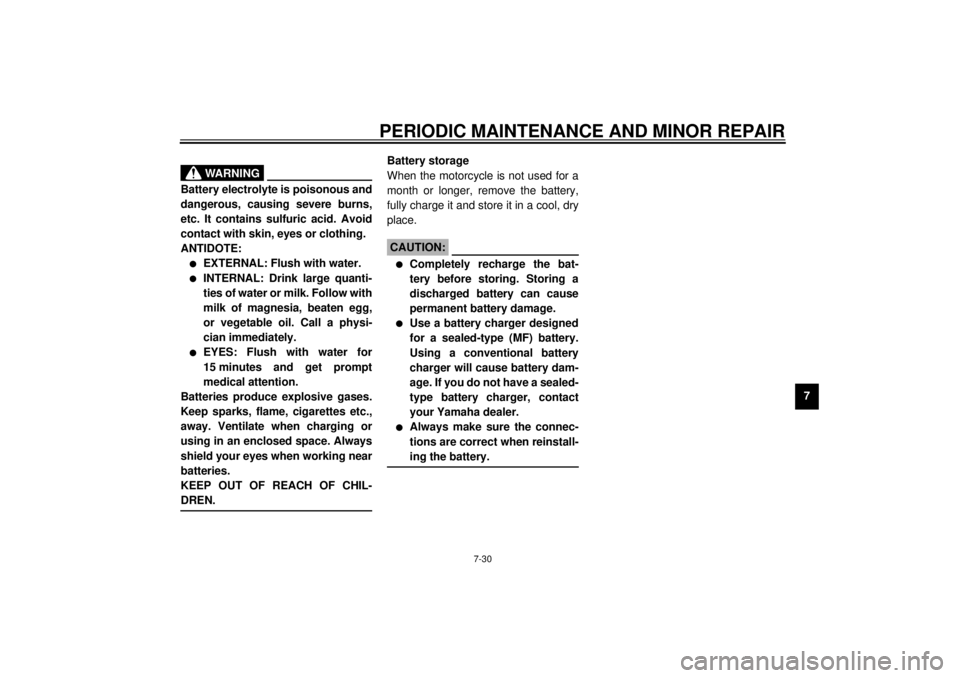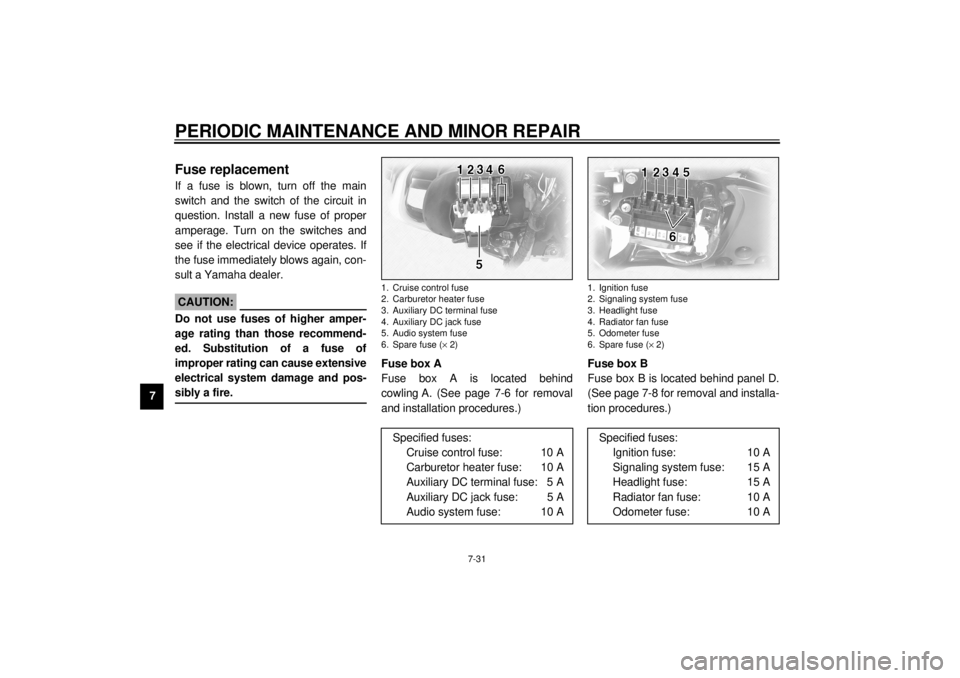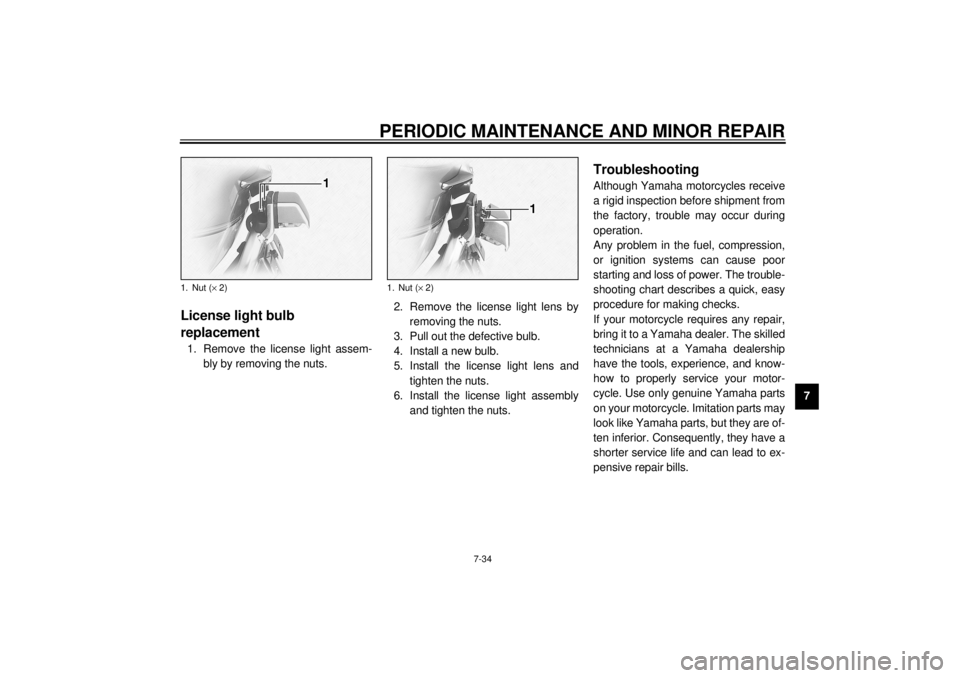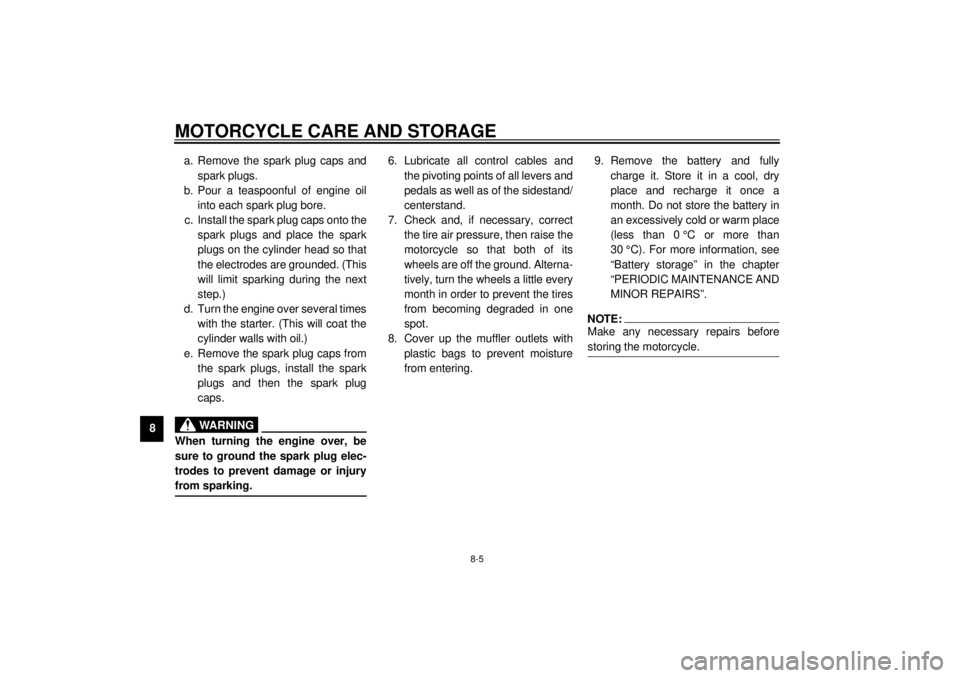Page 96 of 121

PERIODIC MAINTENANCE AND MINOR REPAIR
7-30
7
EW000116
WARNING
@ Battery electrolyte is poisonous and
dangerous, causing severe burns,
etc. It contains sulfuric acid. Avoid
contact with skin, eyes or clothing.
ANTIDOTE:l
EXTERNAL: Flush with water.
l
INTERNAL: Drink large quanti-
ties of water or milk. Follow with
milk of magnesia, beaten egg,
or vegetable oil. Call a physi-
cian immediately.
l
EYES: Flush with water for
15 minutes and get prompt
medical attention.
Batteries produce explosive gases.
Keep sparks, flame, cigarettes etc.,
away. Ventilate when charging or
using in an enclosed space. Always
shield your eyes when working near
batteries.
KEEP OUT OF REACH OF CHIL-
DREN.
@
Battery storage
When the motorcycle is not used for a
month or longer, remove the battery,
fully charge it and store it in a cool, dry
place.
EC000102
CAUTION:@ l
Completely recharge the bat-
tery before storing. Storing a
discharged battery can cause
permanent battery damage.
l
Use a battery charger designed
for a sealed-type (MF) battery.
Using a conventional battery
charger will cause battery dam-
age. If you do not have a sealed-
type battery charger, contact
your Yamaha dealer.
l
Always make sure the connec-
tions are correct when reinstall-
ing the battery.
@
E_5jc_Periodic.fm Page 30 Saturday, October 16, 1999 1:10 PM
Page 97 of 121

PERIODIC MAINTENANCE AND MINOR REPAIR
7-31
7
EAU01801
Fuse replacementIf a fuse is blown, turn off the main
switch and the switch of the circuit in
question. Install a new fuse of proper
amperage. Turn on the switches and
see if the electrical device operates. If
the fuse immediately blows again, con-
sult a Yamaha dealer.
EC000103
CAUTION:@ Do not use fuses of higher amper-
age rating than those recommend-
ed. Substitution of a fuse of
improper rating can cause extensive
electrical system damage and pos-
sibly a fire. @
Fuse box A
Fuse box A is located behind
cowling A. (See page 7-6 for removal
and installation procedures.)Fuse box B
Fuse box B is located behind panel D.
(See page 7-8 for removal and installa-
tion procedures.)1. Cruise control fuse
2. Carburetor heater fuse
3. Auxiliary DC terminal fuse
4. Auxiliary DC jack fuse
5. Audio system fuse
6. Spare fuse (´ 2)
Specified fuses:
Cruise control fuse: 10 A
Carburetor heater fuse: 10 A
Auxiliary DC terminal fuse: 5 A
Auxiliary DC jack fuse: 5 A
Audio system fuse: 10 A
1. Ignition fuse
2. Signaling system fuse
3. Headlight fuse
4. Radiator fan fuse
5. Odometer fuse
6. Spare fuse (´ 2)
Specified fuses:
Ignition fuse: 10 A
Signaling system fuse: 15 A
Headlight fuse: 15 A
Radiator fan fuse: 10 A
Odometer fuse: 10 A
E_5jc_Periodic.fm Page 31 Saturday, October 16, 1999 1:10 PM
Page 98 of 121
PERIODIC MAINTENANCE AND MINOR REPAIR
7-32
7 Main fuse box
The main fuse box is located behind
panel E. (See page 7-9 for removal and
installation procedures.)
EAU01802
Headlight bulb replacementThis motorcycle is equipped with a
quartz bulb headlight. If headlight bulb
burns out, replace the bulb as follows:
1. Disconnect the headlight connec-
tor and remove the bulb holder
cover.2. Turn the bulb holder counterclock-
wise to remove it and remove the
defective bulb.
EW000120
WARNING
@ Keep flammable products and your
hands away from the bulb while it is
on, as it is hot. Do not touch the bulb
until it cools down. @3. Put a new bulb into position and
secure it in place with the bulb
holder.
1. Main fuse
2. Spare fuse
Specified main fuse: 30 A
1. Bulb holder cover
2. Headlight connector
1. Bulb holder
E_5jc_Periodic.fm Page 32 Saturday, October 16, 1999 1:10 PM
Page 99 of 121
PERIODIC MAINTENANCE AND MINOR REPAIR
7-33
7
EC000106
CAUTION:@ Avoid touching the glass part of the
bulb. Keep it free from oil; other-
wise, the transparency of the glass,
life of the bulb, and illuminous flux
will be adversely affected. If oil gets
on the bulb, thoroughly clean it with
a cloth moistened with alcohol or
lacquer thinner. @4. Install the bulb holder cover and
connect the headlight connector.
If the headlight beam adjustment is
necessary, ask a Yamaha dealer to
make that adjustment.
EAU00855*
Turn signal and tail/brake light
bulb replacement1. Remove the screws and the lens.
2. Push the bulb inward and turn it
counterclockwise.3. Place a new bulb in the socket.
Push the bulb inward and turn it
clockwise until it engages into the
socket.
4. Install the lens and the screws.
EC000108
CAUTION:@ Do not over-tighten the screws as
the lens may break. @
1. Don’t touch
1. Screw (´ 2)
1. Screw (´ 3)
E_5jc_Periodic.fm Page 33 Saturday, October 16, 1999 1:10 PM
Page 100 of 121

PERIODIC MAINTENANCE AND MINOR REPAIR
7-34
7
EAU01624
License light bulb
replacement1. Remove the license light assem-
bly by removing the nuts.2. Remove the license light lens by
removing the nuts.
3. Pull out the defective bulb.
4. Install a new bulb.
5. Install the license light lens and
tighten the nuts.
6. Install the license light assembly
and tighten the nuts.
EAU01008
TroubleshootingAlthough Yamaha motorcycles receive
a rigid inspection before shipment from
the factory, trouble may occur during
operation.
Any problem in the fuel, compression,
or ignition systems can cause poor
starting and loss of power. The trouble-
shooting chart describes a quick, easy
procedure for making checks.
If your motorcycle requires any repair,
bring it to a Yamaha dealer. The skilled
technicians at a Yamaha dealership
have the tools, experience, and know-
how to properly service your motor-
cycle. Use only genuine Yamaha parts
on your motorcycle. Imitation parts may
look like Yamaha parts, but they are of-
ten inferior. Consequently, they have a
shorter service life and can lead to ex-
pensive repair bills.
1. Nut (´ 2)
1. Nut (´ 2)
E_5jc_Periodic.fm Page 34 Saturday, October 16, 1999 1:10 PM
Page 101 of 121
PERIODIC MAINTENANCE AND MINOR REPAIR
7-35
7
EAU02990*
Troubleshooting charts
EW000125
WARNING
@ Never check the fuel system while smoking or in the vicinity of an open flame. @
Check if there is fuel
in the fuel tank.1. Fuel
Enough fuel.
No fuel.
Go to compression check.
Supply fuel.
Engine doesn’t start, go to compression check.
Use the electric starter.2. Compression
There is compression.
No compression.
Go to ignition check.
Ask a Yamaha dealer to
inspect.
Remove spark plugs
and check electrodes.3. Ignition
Wet.
Dry.
Wipe clean with dry cloth and correct
spark gap or replace spark plugs.
Ask a Yamaha dealer to inspect.
Engine doesn’t start, ask a Yamaha
dealer to inspect.Engine doesn’t start, go to battery
check.Open throttle half-way and start
the engine.
Use the electric starter.4. Battery
Engine turns over
quickly.
Engine turns over
slowly.
Battery good.Check connections or
recharge.
E_5jc_Periodic.fm Page 35 Saturday, October 16, 1999 1:10 PM
Page 102 of 121

PERIODIC MAINTENANCE AND MINOR REPAIR
7-36
7
Engine overheating
EW000070
WARNING
@ Do not remove the radiator cap when the engine and radiator are hot. Scalding hot fluid and steam may be blown
out under pressure, which could cause serious injury. Open the radiator cap as follows. Wait until the engine has
cooled. Remove the radiator cap stopper by removing the screw. Place a thick rag like a towel over the radiator cap
and slowly rotate the cap counterclockwise to the detent. This procedure allows any residual pressure to escape.
When the hissing sound has stopped, press down on the cap while turning counterclockwise and remove it. @NOTE:@ If it is difficult to get the recommended coolant, tap water can be temporarily used, provided that it is changed to the recom-
mended coolant as soon as possible. @
Wait until the
engine has cooled.
Check the coolant level in the
reservoir tank and/or radiator.
Level is OK.Level is low, check the
cooling system for leakage.
No
leakage.Leakage.
Ask a Yamaha dealer to inspect
and repair the cooling system.Add coolant. (See NOTE.)
Restart the engine. If the engine overheats again, ask a
Yamaha dealer to inspect and repair the cooling system.
E_5jc_Periodic.fm Page 36 Saturday, October 16, 1999 1:10 PM
Page 109 of 121

MOTORCYCLE CARE AND STORAGE
8-5
8a. Remove the spark plug caps and
spark plugs.
b. Pour a teaspoonful of engine oil
into each spark plug bore.
c. Install the spark plug caps onto the
spark plugs and place the spark
plugs on the cylinder head so that
the electrodes are grounded. (This
will limit sparking during the next
step.)
d. Turn the engine over several times
with the starter. (This will coat the
cylinder walls with oil.)
e. Remove the spark plug caps from
the spark plugs, install the spark
plugs and then the spark plug
caps.
EWA00003
WARNING
@ When turning the engine over, be
sure to ground the spark plug elec-
trodes to prevent damage or injury
from sparking. @
6. Lubricate all control cables and
the pivoting points of all levers and
pedals as well as of the sidestand/
centerstand.
7. Check and, if necessary, correct
the tire air pressure, then raise the
motorcycle so that both of its
wheels are off the ground. Alterna-
tively, turn the wheels a little every
month in order to prevent the tires
from becoming degraded in one
spot.
8. Cover up the muffler outlets with
plastic bags to prevent moisture
from entering.9. Remove the battery and fully
charge it. Store it in a cool, dry
place and recharge it once a
month. Do not store the battery in
an excessively cold or warm place
(less than 0 °C or more than
30 °C). For more information, see
“Battery storage” in the chapter
“PERIODIC MAINTENANCE AND
MINOR REPAIRS”.
NOTE:@ Make any necessary repairs before
storing the motorcycle. @
E_5jc_Cleaning.fm Page 5 Saturday, October 16, 1999 1:12 PM